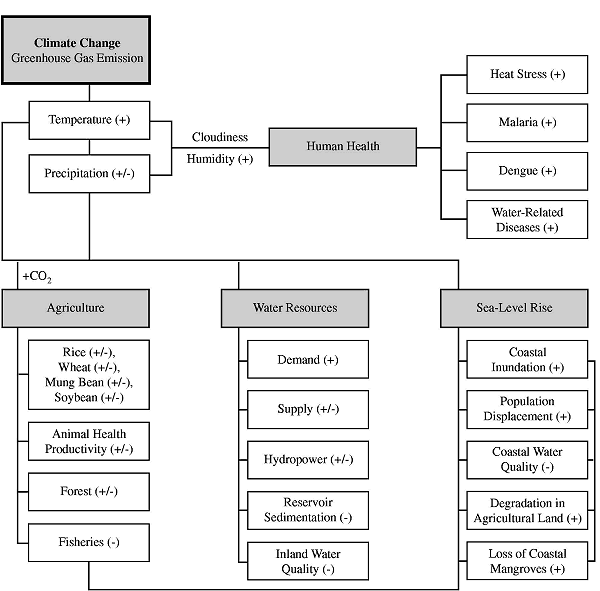|
11.3. Vulnerabilities and Potential Impacts
11.3.1. General Comments
This section discusses impacts that could plausibly result from projected climate
changes. In many studies relevant to Tropical Asia, however, specific scenarios
are not identified; in several cases, assumptions also have been made about
the magnitude and timing of potential climate changes. Four other points are
of special relevance. First, climate change represents an important additional
external stress on the numerous ecological and socioeconomic systems in Tropical
Asia that already are adversely affected by air, water, or land pollution, as
well as increasing resource demands, environmental degradation, and nonsustainable
management practices. Second, most of Tropical Asia's ecological and socioeconomic
systems are sensitive to the magnitude and the rate of climate change. They
also have developed a resilience through their long history of adaptation to
environmental and cultural changes; identifying resilient features is a particular
challenge. Third, Tropical Asia's physical environment is extremely diverse,
and traditional systems of land use are very closely adapted to these conditions.
Such diversity has important implications for assessing the impacts of future
climate change, which would vary greatly from area to area, depending not only
on the climate change scenario but also on specific local conditions and changes
in factors such as population and technology. Finally, the potential impacts
of climate change in Tropical Asia rarely have been quantified. Thus, the results
of impact studies usually are qualitative and often have been directed toward
identifying the sensitivities of specific systems or sectors. In this regard,
considerable progress has been made in recent years in assessing the sensitivity
and vulnerability of some ecosystems, activities, resources, and environments
in the region. This progress is illustrated by the following discussion. Figure
11-3 summarizes the potential impacts of some of the components of climate
change in Tropical Asia.
 |
| Figure 11-3: Possible climate change-related impacts in Tropical
Asia (+ = projected increase, - = projected decrease). |
11.3.2. Ecosystems and Biodiversity
Tropical Asia is rich in natural and managed (crop-related) biodiversity. The
richness in terrestrial and coastal ecosystems can be gauged from the following
facts:
- The rainforests of southeast Asia contain about 10% of the world's floral
diversity.
- The Indo-Pacific borderlands are the center of global shallow-water diversity,
containing the greatest number of coral, mangrove, sea grass, and coastal
fish genera in the world.
In both cases, however, habitat loss and degradation have reached acute levels
(UNEP, 1997).
Potential climate change-related impacts are highlighted in the following examples,
along with other types of human-related impacts.
11.3.2.1. Terrestrial Ecosystems
11.3.2.1.1. Tropical forests
Forests are extremely sensitive to climate change, as well as to other stresses.
Section 1.4 of the Working Group II contribution to the SAR (IPCC, 1996) concludes
that tropical forests are likely to be more affected by changes in land use
than by climate change, as long as deforestation continues at its current high
rate; that any degradation of these forests, whether it is caused by climate
or land-use changes, will lead to an irreversible loss in biodiversity; and
that tropical forests are likely to be more affected by changes in soil water
availability (caused by the combined effects of changes in temperature and rainfall)
than by changes in temperature per se.
Details on the potential impacts of climate change on the forests of Tropical
Asia are provided in Section 11.3.4.2.
|